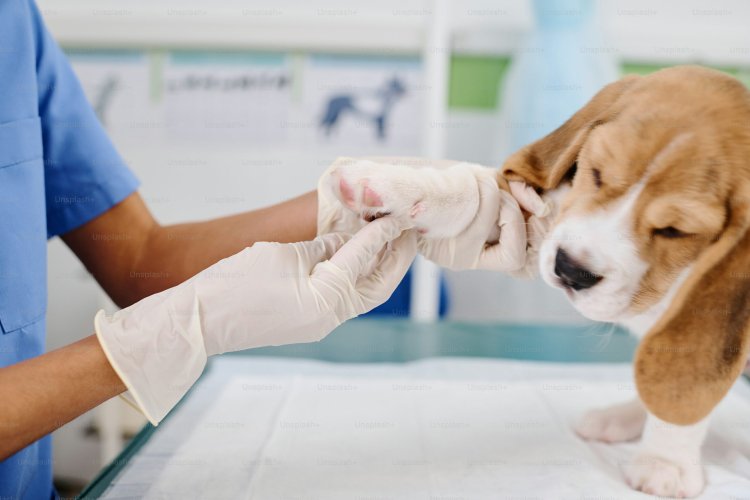How to Prepare Your Pet for a Vet Visit

Taking your pet to the vet can be a stressful experience for both you and your furry friend, especially if it’s their first time or if they have had negative experiences in the past. However, with a little preparation, you can make the visit smoother, reduce anxiety, and ensure your pet gets the best care possible. Whether you're heading to Pawsy Clinic or another trusted veterinarian, here’s a detailed guide on how to prepare your pet for their vet visit.
Get Your Pet Used to Their Carrier or Leash
For many pets, trips to the vet involve being placed in a carrier or being put on a leash, and these items may not always be their favorite. The more comfortable they are with these tools, the easier the vet visit will be.
- Carrier Training for Cats and Small Animals: If you're taking a cat or small animal to the vet, get them used to their carrier well before the appointment. Place treats or toys inside the carrier and let them explore it on their own. Gradually increase the amount of time they spend in the carrier, so they don’t associate it with something scary or unpleasant.
- Leash Training for Dogs: If you're bringing a dog, ensure they’re comfortable with their leash. Practice walking them with it in a calm, familiar environment before the visit. For some pets, just the sight of the leash or carrier can trigger anxiety, so gradual positive associations will help.
Make the Journey as Comfortable as Possible
For pets, car rides to the vet can be stressful. Taking steps to make the journey as calm as possible can set a positive tone for the visit.
- For Cats: Cats often feel more secure in a closed carrier during car rides. You can place a familiar blanket or towel inside to help them feel more at ease.
- For Dogs: Dogs may enjoy the car ride more if they have access to their favorite toy or a blanket. Try to keep them calm by avoiding loud noises or sudden movements in the car.
- Medication for Anxiety: If your pet suffers from extreme anxiety during car rides, talk to your vet about possible medications or calming supplements that could help.
Keep Your Pet Calm and Relaxed Before the Appointment
A calm, relaxed pet is more likely to be cooperative during the vet visit. There are several ways to help reduce stress before you even leave the house.
- Exercise Beforehand: Take your dog for a walk or engage in some playtime before the appointment. A tired pet is often a more relaxed one and may be less anxious in the waiting room.
- Avoid Feeding Right Before the Visit: If your pet is due for a vaccination or a blood test, avoid feeding them right before the visit. Some vets prefer pets to fast beforehand to get accurate test results. Check with your vet for specific instructions about this.
- Use Calming Products: Consider using calming sprays, pheromone diffusers, or collars specifically designed to reduce anxiety in pets. These products release scents that can help your pet feel more at ease.
Bring Any Necessary Documents or Information
Before the visit, gather any important information that your veterinarian might need to better care for your pet. Having these documents ready will help ensure that your pet’s health history is up to date.
- Health Records: Bring any medical records your pet has from previous vets, including vaccination histories, past surgeries, and any current medications.
- Medication List: If your pet is on any medication, be sure to bring a list of them, including dosages and schedules.
- Insurance or Payment Information: If you have pet insurance, be sure to bring your policy details. Also, have payment methods ready for any fees or co-pays that may be due.
Prepare Your Pet for Handling at the Vet
At the vet's office, your pet may be handled by the veterinarian or technicians for a physical exam or other procedures. Preparing your pet for gentle handling can help them feel less anxious and more cooperative.
- Practice Touching Sensitive Areas: If your pet is sensitive to certain areas being touched, like their paws, ears, or mouth, gently practice touching those areas at home. Use treats and praise to create positive associations with being handled in these spots.
- Brush Your Pet's Coat: Brushing your pet before the visit not only helps keep them clean but also helps them get used to being handled. It also allows you to check for any unusual lumps or bumps that you can discuss with the vet.
- For Cats: Cats may be more sensitive to being touched, so if your cat is going to have their ears or teeth checked, practice touching those areas lightly before the visit to reduce fear.
Be Ready to Share Information with Your Vet
When you arrive at the vet's office, you'll likely be asked questions about your pet’s health, behavior, and any symptoms they’ve been showing. Be ready to provide as much detail as possible.
- Behavioral Changes: Let the vet know if you've noticed any changes in your pet’s behavior, such as changes in eating habits, energy levels, or bathroom routines. These can often provide clues about underlying health issues.
- Physical Symptoms: If your pet has been showing any signs of illness, like vomiting, diarrhea, or coughing, be prepared to describe the frequency and duration of these symptoms.
- Diet and Lifestyle: The vet may ask about your pet’s diet, exercise routine, and overall lifestyle. Keep track of what your pet eats and their daily activity levels to provide a complete picture.
Stay Calm and Positive
Pets can often pick up on their owners’ emotions, so staying calm and positive during the visit can help your pet feel more secure. If you’re nervous or stressed, your pet may pick up on those cues and become anxious as well.
- Stay Calm During the Appointment: If your pet starts to feel stressed during the vet visit, try to remain calm and speak to them in a soothing voice. Your reassurance can help ease their anxiety.
- Use Treats and Praise: Bring some of your pet’s favorite treats to offer as rewards during the visit. This positive reinforcement can help your pet associate the vet with something pleasant.
Prepare for the Post-Visit Routine
Once the vet visit is over, you may have some follow-up instructions, medications, or changes to your pet’s routine. Be prepared to follow through on these recommendations to ensure your pet’s continued health and comfort.
- Follow-Up Care: If the vet prescribes medication, make sure you understand the dosage and administration schedule. If there are any dietary or lifestyle changes recommended, take notes so you can stick to the plan.
- Post-Visit Rest: After the vet visit, your pet may need some time to rest, especially if they had a stressful experience or received vaccinations. Make sure they have a quiet and comfortable space to recover.
Conclusion
Preparing your pet for a vet visit doesn’t have to be a stressful experience. By getting your pet accustomed to carriers and leashes, keeping them calm before the visit, and gathering all necessary information, you can make the experience easier for both you and your pet. A well-prepared pet will have a smoother vet visit and will be more likely to feel comfortable with their care provider, whether you're visiting Pawsy Clinic or any other trusted veterinary clinic. The more proactive you are in preparing, the more positive the experience will be for everyone involved!
What's Your Reaction?
















